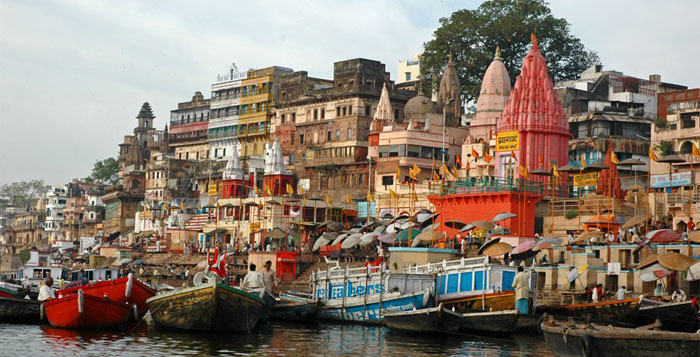
The Burning Ghats of Varanasi
Varanasi (Benares, Banaras, Kashi), on the left bank of the Ganga (Ganges), is one of the seven sacred cities of the Hindus. Among the oldest continuously inhabited cities of the world, its early history is that of the first Aryan settlement in the middle Ganga valley. By late 2nd millennium BCE, Varanasi was a seat of Aryan religion and philosophy and a commercial and industrial centre famous for its muslin and silk fabrics, perfumes, ivory works, and sculpture.
It was the capital of the kingdom of Kashi during the Buddha’s time (6th century BCE), who, after achieving enlightenment, gave his first sermon at nearby Sarnath (it is said that he purposely avoided this hotbed of Brahmanism). The Chinese traveler Hiuen Tsiang visited Varanasi in c. 635 CE and saw it as a centre of art, education, and religion. The city, he wrote, extended for about 5 km along the western bank of the Ganga.
Varanasi declined during the early centuries of Muslim rule in India (from 1194). Its temples were destroyed and its scholars fled to other parts of India. In the 16th century, Akbar brought some relief to the city’s religious and cultural activities. Fresh setbacks came with Aurangzeb but the Marathas again sponsored a revival. It became an independent kingdom in the 18th century. Under the British it remained a commercial and religious centre; in 1910 it became a new Indian state (until 1949).
Varanasi has the finest religious river frontage in India, with miles of ghats (steps) for bathing; shrines, temples, and palaces rise tier on tier from the bank. Over a million pilgrims visit each year; many hope to die there in old age. A center of learning through the ages, it now has three universities, including the large Banaras Hindu University (estd. 1915), and over a dozen colleges. Besides being a centre of arts, crafts, music and dance, it is still famous for its production of silks (and brocades with gold and silver threadwork), as well as for wooden toys, bangles made of glass, ivory work, and brassware. ♣
My most memorable experience in Varanasi was visiting the burning ghats. The bigger of the two is Manikarnika, the other is Harishchandra. The former hosts up to 200 cremations each day. The process is efficient and businesslike. Above the ghats are huge stacks of wood; the family of the diseased, according to their means, buys one of many funeral packages on offer, including a certain quantity of wood, sandalwood sawdust, ghee, other ritualistic paraphernalia, and a priest’s services.
Orderlies set up the pyre, the body is placed on it, the priest chants and performs the rituals, ghee is poured on, and the pyre is set alight, as the men of the family watch (women stay at home). If the fire doesn’t catch on well, more ghee and sawdust are added. If a family can’t afford enough wood, as is not uncommon, the body is burned in stages: middle part first, while the head and legs stick out, to be pushed in deftly by a pole after the middle part collapses.
A few hours later, the ashes and bits of bones are gathered by the eldest son or a senior male of the family and consigned to the waters, where “untouchables” stand with wire nettings to dredge up the ash and mud, hoping for a gold tooth or nose ring that may have survived the fire (pieces of jewelry may be left on the diseased by the family). Not all who die are cremated — children under five, lepers, sadhus, pregnant women, and snake-bite victims are offered directly to the river.
Watching the spectacle, I felt a liberating calm visit me. Few better ways to peer into the abyss and see our common fate, laid out evocatively in the Book of Common Prayer: from earth to earth, ashes to ashes, dust to dust. Why, there is nothing morbid about death. It is a simple fact of life that should inform our everyday choices and opinions. Yet, the greatest wonder of all, as Yudhisthira says in the Mahabharata, is that each day death strikes, and we live as though we were immortal.




